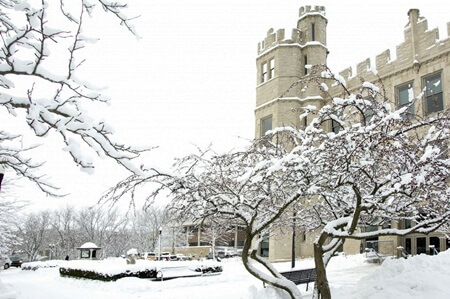 With the unseasonably frigid air this week, memories resurfaced of last winter’s biting cold, brought on by the dreaded polar vortex.
With the unseasonably frigid air this week, memories resurfaced of last winter’s biting cold, brought on by the dreaded polar vortex.
But as NIU climatologist David Changnon points out, it’s not simply the cold that makes us miserable.
Changnon, who has been studying the impacts of last winter for an upcoming publication, can describe the countless ways in which the winter hurt, ranging from U.S. flight delays and Great Lakes shipping slowdowns to a plethora of potholes and water main breaks.
It all amounted to an economic punch in the nose.
“For a national economy still recovering from the damaging recession of 2008, last winter helped to create a significant setback,” says Changnon, a Board of Trustees Professor from NIU’s Department of Geography.
“Economists reported that half of the economic slowdown last winter was due to the bad weather conditions. For example, Ford attributed $100 million in losses to the winter. Because more people stayed inside due to the extremely cold conditions and reduced their spending, the national GNP shrank at an annual rate of 2.1 percent from January to March.”
In January, two extreme “polar vortex” cold-air outbreaks brought historically cold weather into the Midwest and changed the whole complexion of the winter. Gleaned from a thorough review of news stories, Changnon’s analysis found the following:
- By Feb.18, 75,000 U.S. flights, or roughly 5.5 percent of all flights, had been canceled due to extreme cold or snowfall, the highest number in 25 years.
- Shipping on the Great Lakes was slowed greatly. About 92 percent of the lakes were covered by ice in early March, the second highest percentage on record behind the 1978-79 winter. Shipping on the lakes was down 37 percent in January 2014 when compared to the previous January. By late winter, a typical three-day trip through the Great Lakes was taking nine days.
- By March 11, Chicago had spent $2.8 million filling about 240,000 potholes. This large number of potholes led to a record number of complaints and substantial payouts to those whose cars required repairs.
- The frequent number of small to moderate snowfalls in the Midwest caused snowplow drivers to work an unusual number of overtime hours, further impacting road maintenance costs for local and regional governments.
- Energy costs soared nationally. The unit price for natural gas increased between 75 percent and 100 percent by the end of March.
- Perhaps those most impacted by increasing utility costs were rural Midwestern propane users. Costs began to rise in December and escalated in January and February as extreme cold persisted and shortages developed. These factors caused propane costs to more than double.
- The depth of freezing temperatures in the soil profile increased. By mid-February, when frost depths were reported to be between four and five feet, many communities experienced frequent problems with frozen underground pipes and water mains. In some cases, parts of communities were without fresh water for up to a month. In Moline, Ill., the city experienced 61 water main breaks by Feb. 13, and in Des Moines, Iowa, officials indicated that the city had never endured a higher number of broken water mains.
- Overall, a potentially larger concern was exposed. Much of the Midwest infrastructure is old, including buried water mains, sewer lines, roads and other structures. It was pushed beyond its limits by continuous sub-freezing conditions and frequent snowfalls. Costs related to the winter will continue to add up as repairs are completed and newer infrastructure is installed.
- There were also health and safety impacts. For example, weather kept folks from donating blood, more house and apartment fires occurred due to space heaters, and 26 people died in Chicago from hypothermia.
- Nature was affected as well, sometimes in ways you wouldn’t expect. For instance, temperatures were too cold for trees to release maple syrup.
There was some good news, Changnon adds.
- It was much easier for meteorologists to predict the extreme polar outbreaks than it is to predict heavy snowfalls. So most “risk-adverse” decision makers – from homeowners to leaders of schools and large institutions and organizations – were able to make timely and wise weather-related decisions to minimize socio-economic losses.
- Fewer yard signs went up during primary elections because of the frozen ground.
- Snowplow drivers had a very good year.
 Changnon says the impact of the November 2014 polar vortex should be minimal, because it’s not occurring in the heart of winter. It’s unclear whether it is a predictor of the winter to come.
Changnon says the impact of the November 2014 polar vortex should be minimal, because it’s not occurring in the heart of winter. It’s unclear whether it is a predictor of the winter to come.
“This may be the only major polar vortex event of the entire cold season,” Changnon said. “Since the complex factors that create such a scenario can change independent of one another and at different time scales, it is just hard to say.
“However, one of the main causes for last year’s frequent occurrence of the polar vortex, a large body of ocean with above average sea-surface water temperatures in the north Pacific, still exists. So many long-range winter forecasters feel like the probabilities are weighted toward a number of polar vortex events this cold season. It might not be as extreme as last year, but we might see more of the polar vortex than we typically experience.”

